Fall and winter fishing around the Bay is “cooler” than you think
The leaves have fallen, the weather is turning chilly, and you’ve replaced your shorts and T-shirt for pants and a parka – but that’s no reason to hang up your fishing pole.
If you’re an angler looking to keep up the sport year-round, you need to get acquainted with two fantastic fish you can catch in the Buzzards Bay region during the cooler months: rainbow trout and tautog. Though these two fish are very different, they share the distinction of being lots of fun to catch, and (like many New Englanders) that they don’t mind staying out even when temperatures drop.
Before you head out, don’t forget that the state of Massachusetts requires individual state-issued permits for recreational freshwater and saltwater fishing. All fishing licenses expire at the end of the calendar year, so make sure to renew if you want to keep fishing into the New Year!
Rainbow Trout
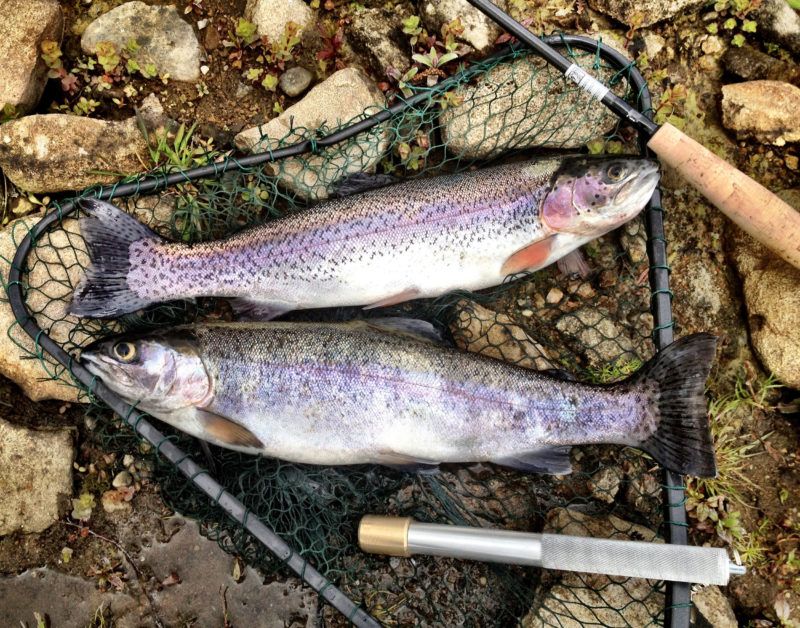
Stocked by the state for recreational fishing, rainbow trout provide fun fishing for anglers of all ages during the fall and winter season.
Rainbow trout are freshwater fish, easily identified by their leopard-like spots and the blush of pink that runs from their cheeks down their sides. Though these striking relatives of the salmon are native to the west coast, Massachusetts – alongside many other states in New England – stocks the fish for recreational angling in the winter and the spring. Close to 60,000 rainbow trout, all 12 inches or longer, were stocked in Massachusetts ponds between early September and early October, including several in the Buzzards Bay region.
Small fish are easy to catch and make a great introductory fish for young anglers, while larger individuals can put up a good fight and provide endless entertainment for the more experienced.
Though stocked rainbow trout do not reproduce, some stocked fish can hold over from year to year in cooler waters, allowing them to grow up to 20 inches long. There is no state size limit for rainbow trout, but during the fall/winter season (September 11 to March 31), anglers are limited to taking no more than 3 trout daily.
How do you fish for rainbow trout?
Rainbow trout are not picky eaters, munching down on everything from flying insects and larvae to worms to tadpoles and small fish. As such, these fish can be caught with many different kinds of live bait. Whole earthworms, small mealworms, and minnows are easy bait to start with. Live bait should be used on a bottom rig with a small sinker. If you prefer fishing with a lure, rainbow trout will go for small spinners and spoons. After you cast, let the lure drop to the bottom, then quickly reel it in for the fish to chase. Trout can also be caught by fly-fishing, though be warned: their wariness in selecting a fly to chase makes them an addictive challenge.
Any freshwater setup will work for trout fishing, but experts recommend sticking with lightweight gear for the best experience chasing after these small, lively fish. You’re also better off with the thinnest, most transparent line you can manage; trout have good eyesight, and can be scared off by the sight of a line, especially in a pond where lots of fishing is happening. Perhaps for the same reason, Andrew Burke of My Fishing Cape Cod recommends trout fishing when the sun is low in the sky, especially in the 45-minute window just before dusk.
Where can I catch rainbow trout around Buzzards Bay?
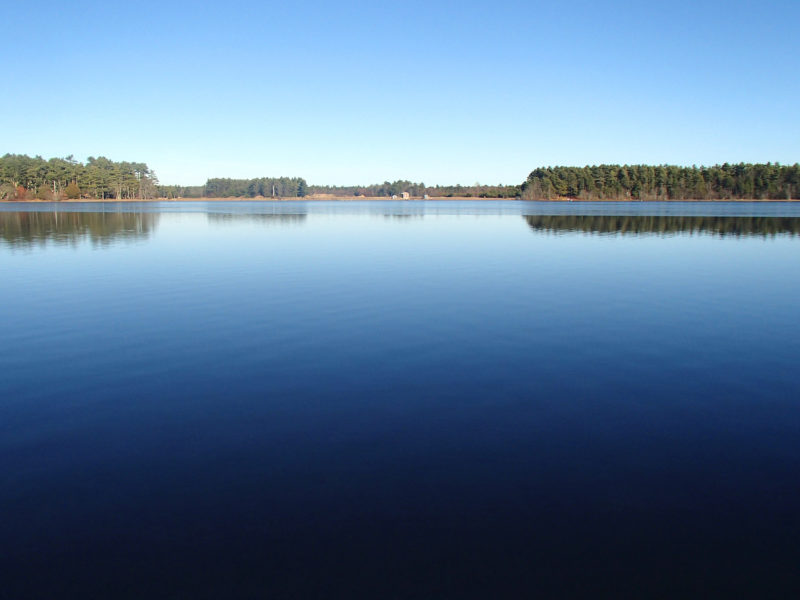
Mary’s Pond, a natural kettle pond in Rochester, provides calm waters and a shallow edge that’s perfect for fishing.
There are four places in the Buzzards Bay watershed where the state stocks rainbow trout every fall. For more trout stocking locations and details about this year’s season, visit the Mass.gov trout stocking report website.
1. Mary’s Pond (Rochester)
A “kettle hole” formed by passing glaciers, Mary’s Pond is a popular destination for fishing year-round. Its easy, safe shoreline access also makes it perfect for teaching kids how to cast their own lines into the shallows.
2. Fearing Pond (Plymouth)
Fearing Pond is one of dozens of kettle ponds located within the vast Myles Standish State Forest. This shallow, relatively small pond is great for wading, though you can fish from a small boat or canoe as long as it does not use a motor. Boats can be launched from the small ramp on the north end of the pond.
3. Big Sandy Pond (Plymouth)
For a fantastic day of freshwater fishing, launch your boat into Big Sandy Pond from the Big Sandy Pond Boat Ramp. Trailered boats can access the pond at this concrete ramp on the pond’s southeast shore. If you prefer to fish from a kayak, you can also launch paddlecraft from this point. Unlike some other local ponds, Big Sandy Pond is crystal clear, with very little vegetation to tangle your line in.
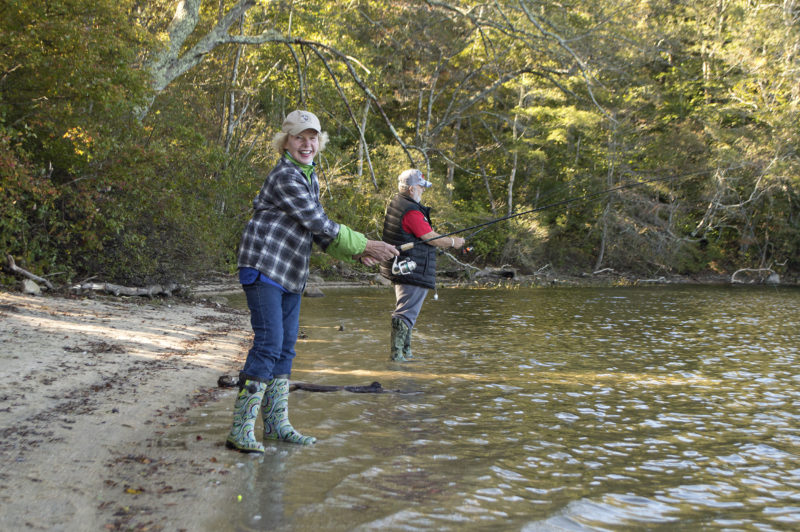
The waters of Grews Pond are a great spot for freshwater fishing year-round.
4. Grew’s Pond (Falmouth)
The centerpiece of Falmouth’s Goodwill Park, Grews Pond transforms from a family swimming hole to a fishing hotspot in the fall and winter. The shallow, sandy edge is perfect for wading. Canoes can also be launched from the shoreline, but no motorized boats are permitted.
Tautog
On the Water magazine calls fall fishing for tautog “one of the most fun and addictive fisheries we have.” Also known as blackfish, tautog are stout, toothy, and long-lived, reaching more than 30 years old and getting up to 10 or even 20 pounds over those years. These bottom-dwelling fish are one of the trickiest fish in the ocean to land – and one of the most fun.
Buzzards Bay’s primary tautog fishing season runs from October 15 until December 31, during which anglers are limited to five fish of 16 inches or greater. Be aware that tautog fishing closes in Massachusetts after January 1, and reopens again during the spring run at the start of April.
How do you fish for tautog?
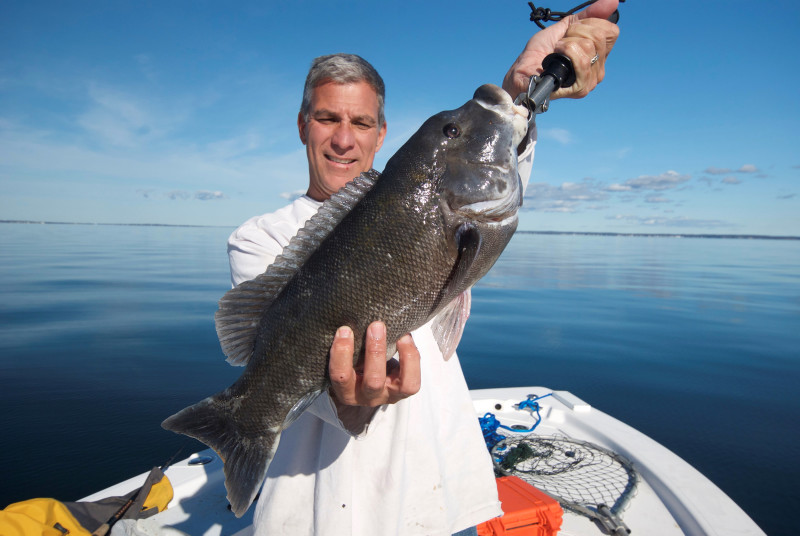
Tautog are bottom-dwelling fish you’ll find hiding near rocks, reefs, piers, and ledges. (Image: Tom Richardson/New England Boating)
You’ll need a boat to find your way to most good tautog fishing, but the trip is well-worth the bundling up you’ll need against the Bay’s late-season chill. The first step in landing a “tog” is safely anchoring your boat directly over one of the bottom features where they hide. Tautog like hard structures, like rock piles, reefs, and shipwrecks, in deep waters. On the Water recommends using a grappling hook with flexible arms rather than a conventional anchor, which can easily get stuck.
Tautog feed primarily on shellfish, from crabs and lobsters to clams, mussels, and even barnacles. Whole crabs of any size, minus their claws and legs, make for great bait; just run a hook through one of the leg holes and out another. With larger crabs, you can halve or quarter the shell. A simple setup of heavy-weight line with a hook and sinker will do, but use a rig with as few beads, swivels, or hooks as possible to keep your line from getting caught on the tautog’s preferred hiding spots.
Resist the urge to try and set the hook when you feel a hit: the only way to catch tautog is wait until the fish swallows the bait. Only then do you set your hook, and start to reel as fast as you can! Once on the hook, the tautog will give one of the best fights you can find as it tries to return to the bottom.
Inevitably, some of these fish will fight their way back to the bottom and into a crevice, leaving you stuck. If that happens, try moving around to apply pressure from different angles, or letting the line go slack to hope the fish swims out on its own.
Where can I catch tautog around Buzzards Bay?
Buzzards Bay is full of the rocky underwater features that tautog love, and anyone with a bottom profiler can chance upon good tautog fishing with a little scanning. But there are a few spots around the Bay that are known to be tautog magnets.
Be sure to check tides and weather before you head out, given tautog are drawn to the very spots that can be most dangerous for a boat.
1. Westport River & Gooseberry Island (Westport)
Earlier in the fall, tautogs can be found hanging around rocks, pilings and bridges around the mouth of the Westport River, especially by the Route 88 bridge. As the waters cool in mid-October, tautog usually move out to deeper water off Gooseberry Island.
2. Dumpling Rocks & The Sandspit (Dartmouth)
These rocks and ledges just off Round Hill in Dartmouth are not far offshore, but can offer great tautog fishing. This spot is also a great place to catch striped bass in the spring.
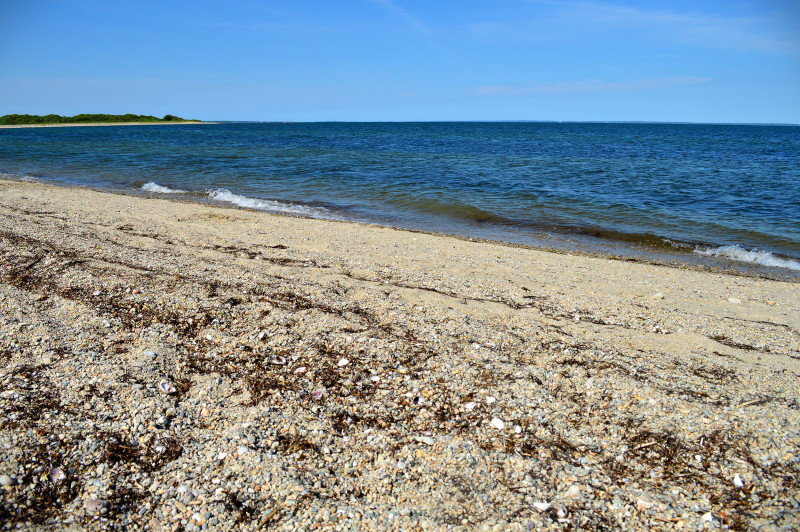
The rocky ledges offshore of West Island make it great for tautog fishing, and its sandy beach is one of the few places you may be able to catch these fish from shore.
3. West Island (Fairhaven)
The rocky ledges offshore make West Island for great tautog habitat. Launch from Hoppy’s Landing to anchor off the island, or try your luck fishing from the causeway or town beach.
4. Cleveland Ledge (Bourne)
Easily spotted thanks to the blocky lighthouse built atop it, this underwater plateau is known for its spring tog fishing, but it’s also a good spot to check out in fall.
5. Weepecket Islands (Gosnold)
Cruise along the edge of the Elizabeth Islands and you’ll find an abundance of rocks, drop-offs, and holes where tautog like to hang out. The rocky Weepecket Islands are a particularly good spot to stop in and lure tautog from their underwater hidey-holes.
6. Quicks Hole (Gosnold)
A narrow strait between Nashawena and Pasque islands, Quicks Hole is a major destination for anglers in Buzzards Bay. Swift currents sweep small fish through this passage between the Bay and Vineyard Sound as the tide moves in and out. Tautog can be found on either sides of the Hole in the fall, often lingering around North Rock and South Rock.
7. Sow & Pigs Reef (Gosnold)
Though it’s famous for striper fishing, this reef at the very tip of the Elizabeth Islands also provides great tautog habitat. Shallow rocks and strong rip currents make this a spot only suitable for experienced boaters.